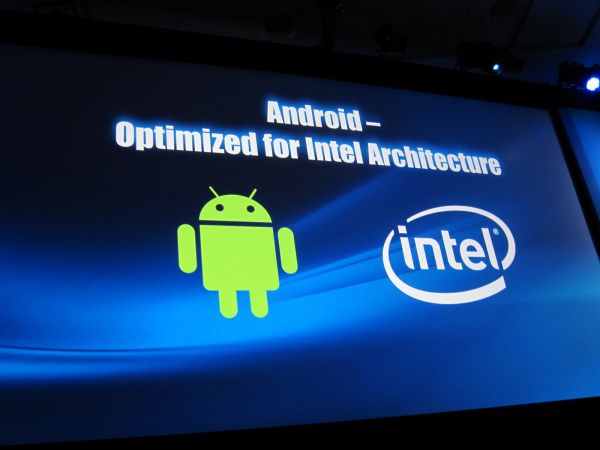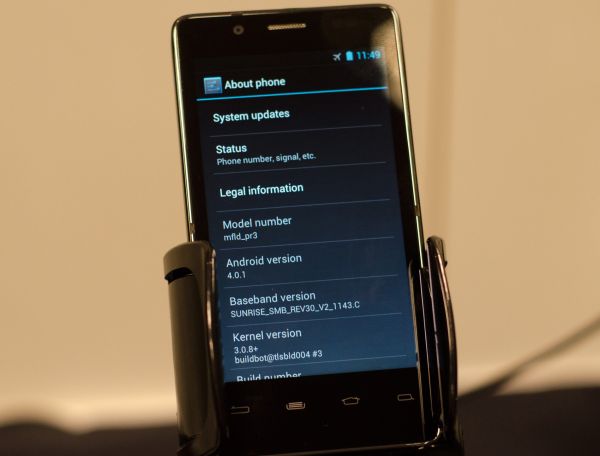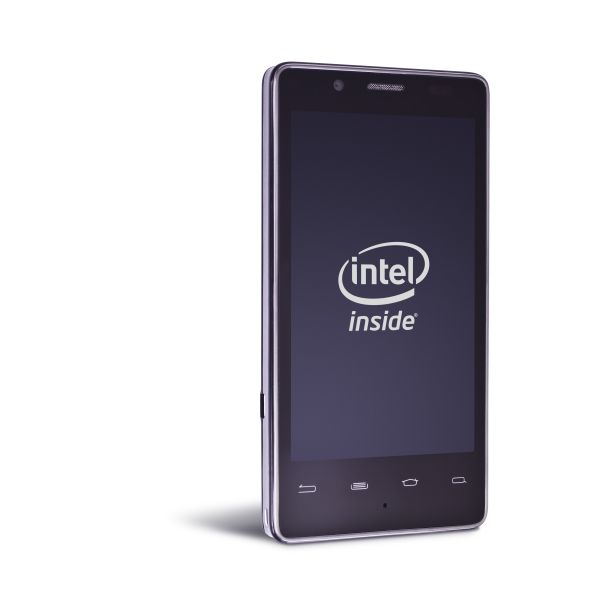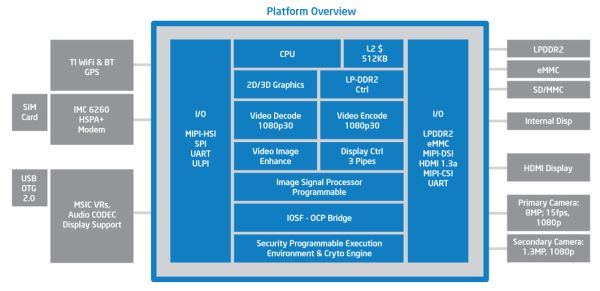Intel's Medfield & Atom Z2460 Arrive for Smartphones: It's Finally Here
by Anand Lal Shimpi on January 10, 2012 8:00 PM ESTWhat's Different This Time Around: Google & A Sweet Reference Platform
Intel has been talking about getting into smartphones for a couple of years now, but thus far it hasn't been able to secure a single design or partnership that that resulted in a product actually coming to market. This time around, things are different. The major change? Focus, and Google.
Intel originally had ambitions of enabling its own mobile OS with the help of Nokia (Moblin/MeeGo). Intel also wanted to support Android as well, however its attention was clearly more focused on the Moblin/MeeGo effort. Similar to the wake up call that pushed NVIDIA to focus exclusively on Android, Intel has now done the same.
At IDF last year Intel and Google announced a partnership and the intention to bring all future versions of Android, starting with Gingerbread, to x86. Since then Intel has ramped up the software engineering engine, going into the Android source code (Gingerbread, Honeycomb and now ICS) and fixing bugs. Intel's goal is to deliver the most stable version of Android as a result of its efforts. Intel is also submitting its changes upstream to the AOSP, which should help improve the Android experience even on ARM platforms.
Under the leadership of Mike Bell (formerly of Apple and Palm), Intel has also created an extremely polished Medfield reference design. This is the same design shown off at IDF last year (apparently there's an even thinner one floating around somewhere), but what separates it from other reference designs we've seen from SoC vendors is that the Medfield reference platform was designed to be a polished phone that could theoretically be rebranded and resold.
Intel knew the onus was on itself to prove that Medfield, Atom and even just x86 was power efficient enough to be delivered in a compelling form factor with competitive battery life. Paul Otellini gave Mike carte blanche access to any of Intel's resources. Instead of having to work with existing Intel groups, Mike was allowed to assemble his dream team of engineers. The team Mike built is what he felt he needed to not only bring Medfield to market, but also to build the a first class Atom based smartphone.
The result is this:
Internally it features Intel's own XMM 6260 HSPA+ modem. Intel claims LTE is on the way although there's no ETA on that.
WiFi in the reference design is provided by TI's 1283 controller. Intel's wireless team does not have a a WiFi solution that's low power enough to work in a smartphone, although after the recent restructuring the team has now been tasked with building an ultra low power solution that can.
The display is a somewhat unusual 1024 x 600 panel, with support for 1080p30 (and 1080i60) output via HDMI. The SoC specs are identical to what I've already discussed: 1.6GHz max CPU clock and a 400MHz GPU clock.
The reference platform is not only smartphone sized, but Intel has built its own qualification labs that mirror those of the carriers to ensure quality and convince its customers of the platform's legitimacy. In essence, Intel has built its own miniature smartphone design and test center.
The Medfield reference platform is available for use by any of Intel's customers, and indeed that's what's already happening. Lenovo's K800 is based on a modified version of Intel's reference platform, and I wouldn't be surprised if more aren't on the way.
All of this sounds a lot like Intel's efforts in the motherboard space over a decade ago where it started providing motherboard manufacturers with reference designs that they could modify if they desired. The effort helped significantly reduce time to market and allowed the motherboard makers to focus more on specializing on what they were good at.
The Medfield reference platform is designed to do the very same for smartphones. Intel wants to provide its partners with a well designed, stable smartphone platform. If they choose to use it, they can shave off a significant amount of development time and spend more of their time on software or simply bring a good reference phone to market in a quick fashion. I'm not entirely sure I've seen many players in the Android space that are actually all that great at software development, but Intel believes anything that shortens time to market will be appreciated.
I asked Intel if it has any plans to offer the reference platform unlocked, direct to customers. Unfortunately the answer at this point is still no. I suspect that Intel is more interested in building its customer base rather than circumventing it.
















164 Comments
View All Comments
stadisticado - Wednesday, January 11, 2012 - link
I think dealcorn is being a bit hyperbolic. That said, even 'competitive' from Intel has to be a big warning sign for sellers of ARM chips.dealcorn - Wednesday, January 11, 2012 - link
I may be wrong and this will be measured by independent observers in due course, but I had no intent of being hyperbolic.If you look at the investor' chart on the first page of the article (where Anand says he knows who they are and what the power ratings are) Medfield ranks first in performance on all 3 tests. On economy it scores 2/6 twice and 3/6 once. When I look at how much they won by and how much they did not win by, my visual computer says "superior". Look at the pictures yourself and exercise your own judgment.
aury - Wednesday, January 11, 2012 - link
"intel did it"Uhm, you might like to show some side by side comparisons of that phone next to an actual phone instead of just the front.
The phone is about twice as thick as a normal phone, it has actual heat disappating sections, which means the chip is likely much hotter than an A9.
All the tests you show are the same ones intel shows on their CES pamflet, i.e. they are freaking useless, since they wouldn't put tests up there that didn't show them at an advantage.
This is not "intel did it", not by a long shot.
Anand Lal Shimpi - Wednesday, January 11, 2012 - link
iPhone 4S thickness: 9.3mm, Medfield reference design thickness: 9.5mm.There's apparently a thinner version but I don't believe the form factor is the issue anymore.
Take care,
Anand
jjj - Wednesday, January 11, 2012 - link
I wouldn't trust Intel data but we'll see,waiting eagerly for real products and real tests,just wish you were more objective when it comes to Intel.The ref platform is rather fat and the battery smaller than what most high end smartphones have so i wouldn't call it sweet.
The partnerships are ,hmm,rather interesting.Lenovo is not exactly a phone maker and while they might shift some volume in China they are not the ideal partner (and they can be payed off with some price cuts and marketing $). Moto AKA Google might have other reasons to do this. Samsung is starting to be too big and Intel competing in this space might slow them down somewhat and Google has no interest in not beeing present on x86 when they scale Android up so another favour after the Google TV deal would not be out of the question.Also with the Moto deal,Intel hurt Nvidia since they are the ones that got kicked out to make room for Intel.
At least ,if the numbers are even somewhat close to reality they could have a good product on 22nm.
aury - Wednesday, January 11, 2012 - link
What people also don't seem to understand is that Intel doesn't need something equal to ARM, it needs something better for anyone to turn an eye.Phone manufacturers control the whole supply line from A to Z when making a phone, it's not like PCs where different manufacturers control different supply line.
Phone makers will not easily switch or change their supply lines, they are locked into huge deals and contracts and unless you offer them something with amazing benefits, they will not change.
Intel offers nothing, they are high cost, they are way behind ARM in power efficiency, they ***** off Nvidia, they **** off qualcomm, they are a direct competitor to Samsung, and this chip is a joke if it will be released by the end of the year, that's why the only partner they have atm is lenovo, because it's a PC manufacturer.
Penti - Wednesday, January 11, 2012 - link
Actually Intel controls plenty and can offer a complete platform. That's more then Apple (Qualcomm and Intel Baseband) or Samsung (Qualcomm and others baseband modems regardless if it is their own Exynos SoC). Neither are they trying to win over Apple. All other manufacturers are totally free from building major hardware / silicon. That is LG, Sony (ex-SE which aren't using ST-E or former Ericsson basebands since a long time), Nokia, HTC, Huawei, ZTE, Motorola Mobility/Google, Hitachi, Fujitsu, Sharp, Panasonic, NEC, Pantech, Research In Motion and more has no semiconductor business connected to application or baseband processors today. That they don't offer SoC IP at foundry level won't matter much here. Neither are they unmovable on the parts. Specially not if they have a good reference platform and BSP/driver-package ready and working. They also have multiple hardware partners and Intel don't expect that to disappear. They were driving those players to ARM to begin with when they had their own architecture.Most turn to companies like TI, Qualcomm, Samsung (Application processor), Freescale, Nvidia (no baseband integration yet or any baseband platform) for chips. Most need to do more engineering then to buy a platform that is ready. It's certainly not PC's. Intel got thousands of ex-Infineon people building baseband and GPS chips and they know the business.
french toast - Wednesday, January 11, 2012 - link
Thers a big alliance already betweem japanese docomto and samsung, and a few other to develop in dies 4g modems. st erickson and qualcomm already provide this service and will be shipping actual phones with this tech inside this year..not 'sometime in 2013'.The reason why manufacturers have gone ARM is not only because they offer better performance and better power levels, they are also cheaper to produce and buy, they also have the option of a quick turn around for specialist designs, or they can design a processor to there own design.
Either medfoeld is going to be sold break even, or its goig to be twice the cost of ARM designs, that are bith more powerfull and power efficient.
Penti - Wednesday, January 11, 2012 - link
On-die baseband hasn't meant that much, regarding custom designs we can see that Apple hasn't gone that route. It hasn't made much sense to force everything into a single chip. It's a nice feature that often doesn't get implemented in actual products and ST-E and Qualcomm haven't and most will not have fully contained LTE-basebands integrated into their SoC this year. Still requires external hardware. You still require application processor, baseband processor, wifi chipset, bluetooth chipset, audio dac, nand memory, display ics, radio hardware (RF IC, RF transceiver) outside of the baseband processor and so on. At least on most Samsung, Freescale, TI, Nvidia and so on hardware. Intel can still put together and market a great single-chip LTE-baseband to compete. That they can't compete in the embedded space is a whole different thing. They are not strong in the automotive field to begin with so why would they try. For mobiles it's all about platform not synthesized IP-blocks. They are still a chip provider the same way as their competitors are when it comes to smart phones.NTT DoCoMos joint venture with Fujitsu, NEC, Samsung, Panasonic and Fujitsu semiconductor don't matter much here it's still a independent modem not an integrated one. Neither should they have much of chips to put out this year as it won't even form until March. Those modems can be used with any application processor. So can baseband modems from Broadcom, Intel, Qualcomm, Altair, ST-Ericsson, Cavium, Sequans and many more.
It is depending on much more how big and complex the actual platform is in a circuit board of a phone or tablet. Remember here that the Intel also has only PoP memory while most do external on board LPDDR(1/2). I'm sure it can be paired with hardware to make it no bigger then much of any competitors. Bom doesn't need to be several times of the competitors, I'm sure it isn't. Neither does it need to compete with none existing 2013 hardware. A SoC like this doesn't cost Intel many dollars to produce. It won't erase everything and outdo everybody but it is good enough for some of the major vendors to try it in some of their models (obviously Android handsets and Tablets).
french toast - Thursday, January 12, 2012 - link
Im sorry, although this isnt an area that i have a huge amount of knowlege on, i can say with some certainty that both Qualcomm and ST-E will have on die baseband shipping this year on 28nm, In qualcomms case the s4 processor that is being demoed with the Asus idea pad has one in.I can also say it has 2 main advantages that i know of (and likely many more that i dont)
1) When put on die and using the same process as in qualcomm and ST-E case it vastly improves power effiecency, a big problem with currant 4g.
2) As most of the components are included on die that you have mentioned, that means more space out side of the die, less hastle for the manufacturers and more space inside the device/phone for things like battery/or smaller device.
Regards to Apple, apple bought PA semi, back in 2007/08 and use it to design its A-series chips, whilst it hasn't used a complete custom licence, they have done some soft optimisations, im not privvy to what they are.
Samsung also acquired intrinsity around the same time, and used their custom logic to some minor power improvements to the cortex core..first seen on the hummingbird..as Apple uses samsung to manufacture there chips, you can bet some of that is licenced too.
Qualcomm ,nvidia (not tegra)and Marvel also have full custom license.